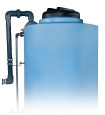The Advantages of Crosslinked Polyethylene Tanks
Chemical storage tanks for water treatment, wastewater treatment and industrial uses are available in three main materials of construction: polyethylene, steel and fiberglass.
When selecting a chemical storage solution, several factors should always be important considerations — including ease of handling, installation, maintenance, resistance to leakage and lifetime cost. This article will explore the advantages of cross-linked polyethylene tanks.
What Is Cross-linked Polyethylene?
Not all high-density polyethylene tanks are created equal. Although they sound nearly identical, linear polyethylene and cross-linked polyethylene (XLPE) chemical storage tanks have significant differences. Those differences could impact your organization’s bottom line, your people’s safety, and the operations of your facility.
Both linear polyethylene and XLPE tanks are made with heated resins to create a cured plastic. However, the differences in their production create very different polyethylenes with very different structural strength.
Cross-linking is simply the formation of bonds between the polymer chains. These bonds tie the polymers together, dramatically increasing the molecular weight. In fact, the length of the polymer chains and, therefore, the physical properties, are much better than can ever be achieved without crosslinking.
The result is a plastic that possesses impact resistance, tensile strength, and resistance to fracture that linear polyethylene simply can’t match. These qualities make cross-linked polyethylene an excellent choice when tank integrity is critical. The structural integrity, heat resistance, and useful life in most cases are unparalleled.
Poly Processing has NSF-61 certification for 38 chemicals on its cross-linked polyethylene tanks.
Advantages and Value of Cross-linked Polyethylene Storage Tanks
Ease of Handling and Installation
Since Poly Processing’s tanks are relatively lightweight and extremely durable, transporting them is easy. Crosslinked polyethylene tanks are shipped using basic freight methods such as common carriers and flatbed tractor trailers.
Fiberglass tanks have special handling requirements, and because XLPE tanks are lighter than steel tanks, freight is cheaper. Additionally, when the tank arrives at your location, it can be offloaded using techniques and equipment commonly available at a job site.
Polyethylene tanks can be maneuvered multiple times until they are ready to install, without fear of damage. All these factors make getting and installing your chemical tank much easier.
Ease of Maintenance
Unlike tanks made of other materials, crosslinked polyethylene storage tanks require limited routine maintenance. Steel tanks require external preventive care such as painting and internal inspection to determine weld integrity. Fiberglass also poses its own issues, such as multiple layer construction and the sensitivity toward micro-cracking.
Leak Resistant
Polyethylene storage tanks are leak resistant because they are a molded, one-piece construction without seams. Steel tanks tend to develop pin leaks over time from rust and corrosion, and they have stress points at welds.
The quality of fiberglass tanks and their resistance to leaks can vary widely due to the method of construction and quality of the manufacture.
The seamless construction and superior inert qualities of polyethylene means less chance of leaks.
Small Differences Have a Tangible Impact
The implications of these differences are most obvious when testing linear and cross-linked polyethylene. When linear polyethylene fails, it can fail catastrophically, because the linear polymer chains tend to “unzip.” In some cases, the entire tank comes undone, and a small leak becomes a major chemical spill. All of the stored product could be lost, and the cleanup can be considerable.
On the other hand, if cross-linked polyethylene develops a small pinhole or tear, the chances of a catastrophic failure are extremely low. You aren’t likely to lose all of your stored chemical if a leak develops, and the cost of cleanup and replacement is typically significantly less expensive. The risk to your employees and the environment can be drastically reduced, as well.
Poly Processing’s drop and pressure test videos offer an excellent demonstration of the structural differences between linear and cross-linked resins.
In most cases cross-linked polyethylene offers longer useful life in the same application as linear polyethylene. While the two plastics are both chemically inert materials, because XLPE has a significantly longer life and less financial impact in case of failure, the total useful life of cross-linked polyethylene is significantly better for your bottom line.
Lifetime Cost Effectiveness of Cross Linked Polyethylene Storage Tanks
In addition to reduced cost to transport, less error-prone installation and reduced need for maintenance, XLPE tanks also last longer than steel and fiberglass tanks.
In particular, high-density crosslinked polyethylene tanks offer longer life and reduced maintenance compared to commodity grade polyethylene tanks. The same holds true with fiberglass storage tanks, where chemicals can wick into the fibers of the tank. This increases the cost of maintenance to detect and repair leaks and reduces the overall life of the tank.
Cross linked polyethylene tanks typically are functional for at least 15-20 years. HDPE and fiberglass tanks sometimes last only a third as long, especially if they are not properly maintained.
When considering a storage tank, keep these three important factors in mind:
- Proper installation is critical to maximizing storage tank life.
- Reducing potential leak points reduces the ongoing responsibility and cost of storing chemicals.
- Tank material can determine the lifetime cost of a tank.
In the end, the advantages of cross linked polyethylene tanks may make your choice an obvious one.
- March 4, 2024
- Topics: Value Added
About Poly Processing
Posts By Topic
Tech Talk Podcast Episodes
Subscribe By Email
Recent Posts
- Installation Tips for Chemical Storage Tanks: Site Preparation and Offloading
- Understanding pH and Chemical Concentration When Choosing a Chemical Tank
- Maximizing Fill Efficiency: Selecting the Optimal Fill Line System
- Chemical Storage Tanks: A Quick Guide for End Users
- Popular Customization Options for Chemical Storage Tanks
Tank Configurator

Find the recommended tank and system components for your chemical storage challenge.
Configure a Tank Package

.jpg?width=878&height=461&name=The%20Advantages%20of%20Cross%20Linked%20Polyethylene%20Tanks%20(1).jpg)






